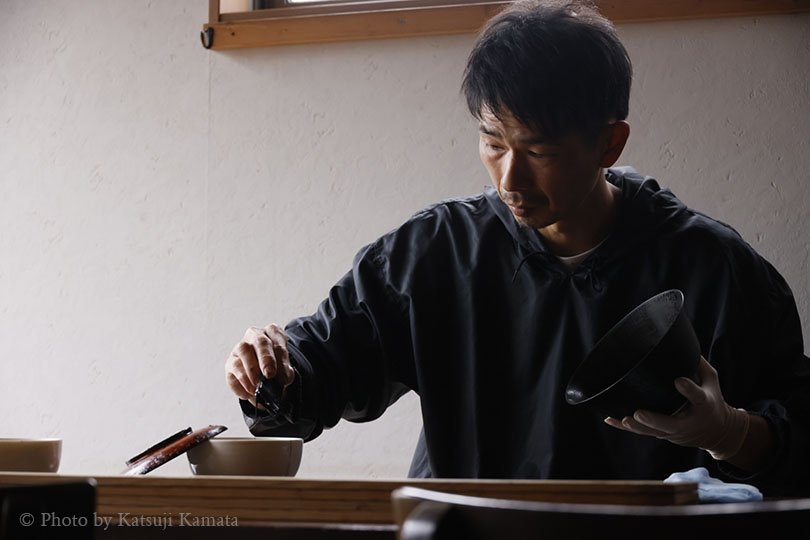I’m pleased by the interest from so many of you wanting to hear about my visit to Wajima and my meeting with the very talented Urushi artist there. So much has happened since my visit—but where to begin?
It all started when one of our clients, the owner of Kosaka, a Michelin-starred sushi restaurant in NYC, reached out to me, asking where she could purchase high-quality urushi bowls. She had hoped to visit Wajima during her trip to Japan in March, but unfortunately, she couldn’t go due to the earthquake damage. Afterward, she searched all over Tokyo but couldn't find any good Urushi bowls for the restaurant. What she wanted was simple yet very beautiful.
I immediately thought of Mr.Kamata's elegant work, which I had admired on Instagram. I found the perfect pieces so placed an order for her. Although production was delayed because of earthquake damage, the Urushi bowls were finally delivered to Kosaka in September. These graceful Urushi bowls are now used in the Michelin-starred restaurant, which ultimately led me to visit Wajima to learn more about his work.
To be more specific, Mr.Kamata is an artist specializing in dry urushi, a method known as "Kanshitsu (乾漆)" in Japanese, one of the traditional urushi techniques. So let me introduce you to Kanshitsu (乾漆) first. This technique was introduced from China during the Nara period (710–794 AD).
The creation process is very long and requires high skills, but to put it simply, Kanshitsu involves layering linen cloth with rice paste+Urush+Jinko* over a wooden or plaster mold, which is later removed. Once the mold is taken away, additional layers of Urushi are applied to create the final piece. While most Urushi ware is made by applying many layers of Urushi over a wooden base, Kanshitsu is different because the wooden mold is only used to shape the piece and is then removed, resulting in an exceptionally lightweight item. This technique also allows for more organic forms. Kamata-san’s work is particularly known for its graceful shapes. He called it “undulation”.
Molds for making Kanshitu (乾漆) - Dry Urushi
After removing the mold and cutting off the unnecessary parts.
You can see more creation process details here.
One of the major advantages of Kanshitsu is that it doesn’t rely on a wooden base, meaning there’s less risk of the Urushi surface cracking or chipping as the wood deforms over time due to dry air. This makes it especially well-suited for drier climates like New York. Wanting to spread the charm of Urushi not only to New York but to the world, I decided to visit Kamata-san without hesitation.
Before going to his studio, he showed me around Wajima, and during the car ride, we heard about the damage caused by the earthquake. His studio and house somehow managed not to get major damage, however, the Urushi works, completed through various processes in cooperation with many artisans, were significantly impacted. Many artisans could not work, leading to considerable expenses. He even purchased a house for his staff.
His studio is located in a vacation home area rich in nature in Wajima on the Noto Peninsula. There was no air conditioning, which made it tough in the humid Japanese summer, but the cold barley tea that his wife served was so delicious that I immediately asked for a second glass. Drinking the cold tea helped cool down my body.
While his assistant worked silently, I asked him various questions about Kanshitsu. When I touched his work, it felt very light and warm, evoking the same feeling I get when I touch something precious. I placed an order for some of his pieces to be sent to me later, as he hadn’t been able to keep up with production.
His assistant is working at his studio.
His son watched us with great interest, silently observing, so I struck up a conversation with him. In August, Kamata-san traveled to England on a business trip for restoration work at the British Museum with his wife, a Maki-e artist, and their two children. The whole family went together, and I thought what a wonderful life they had. His son spoke a little English with my American partner, which made for a fun and memorable experience.
Time flew by, and before it got too late, I asked him to call a taxi to take us to an inn in Wakura Onsen, which was over an hour away by car since there were no accommodations available in Wajima due to ongoing repairs after the earthquake. When the taxi arrived, they kindly helped us with our luggage. We wanted to talk more, but we had to head to the inn. The next day, he was leaving for Tokyo for his exhibition.
To be continued.
Kamata-san and his son were waving goodbye to us.
Jinko* is processed diatomaceous earth.





